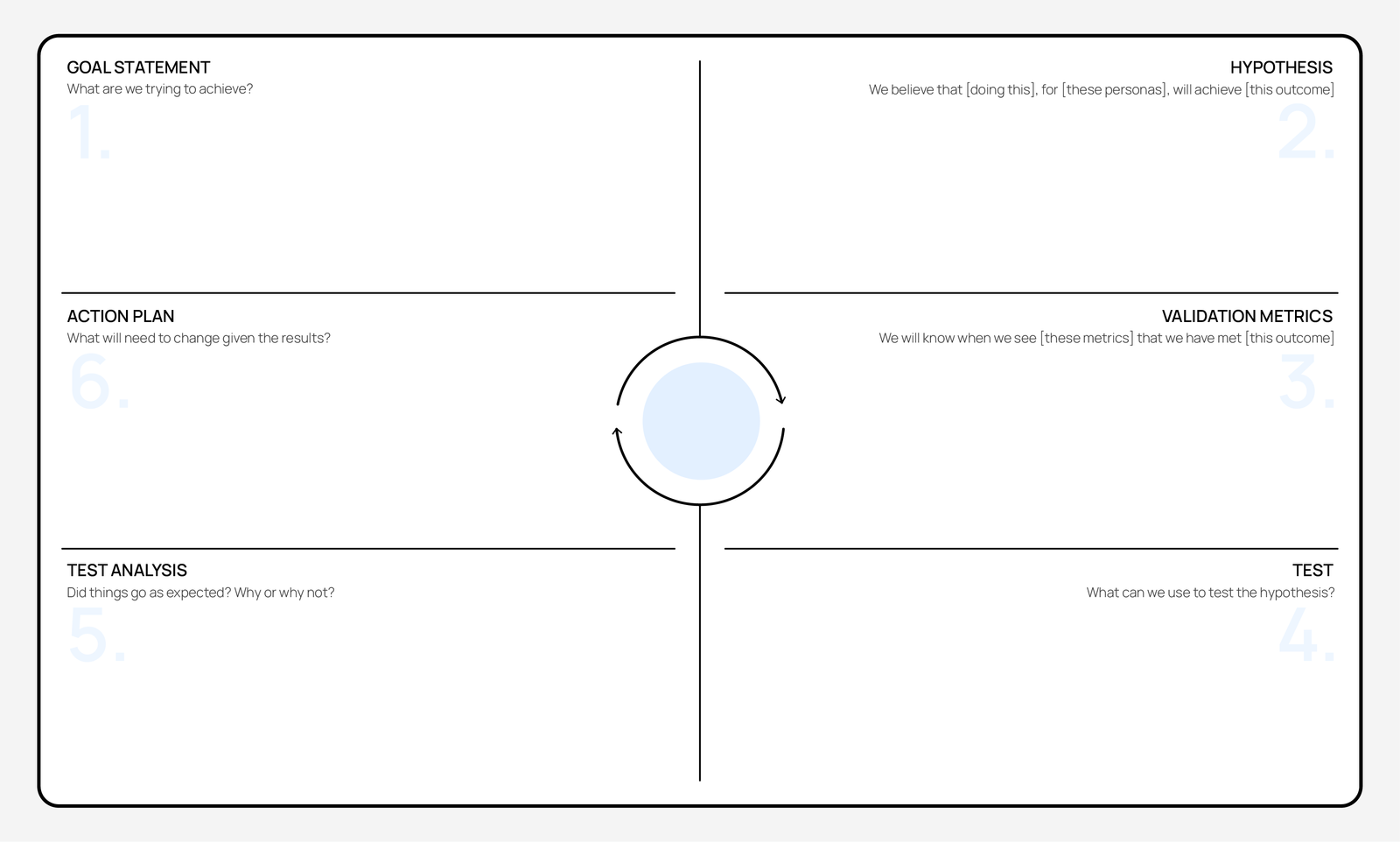Hypothesis-Driven Development
Hypothesis-Driven Development is an iterative process used to test ideas and determine if they are viable
Hypothesis-Driven Development begins with developing a hypothesis — a testable statement about an idea (usually a product or feature). The hypothesis is then validated through experimentation.
Key concepts in Hypothesis-Driven Development include:
Hypothesis: A specific, testable statement that predicts how users will respond to an idea
Experimentation: Experiments designed to gather data on the hypothesis.
Metrics: Measurements of user responses which validate or refute the hypothesis.
Evidence-Based Decision Making: Using the collected data to make informed decisions about whether to proceed with, pivot, or abandon an idea.
This approach is closely aligned with lean startup principles, focusing on minimising waste by validating ideas early and iterating quickly based on real user feedback.
The results
- Solutions that meet real user needs
- Information to support decision making

When to use it
Product Development: When creating new products or refining existing products
Service Design: When designing or improving services
Business Improvement: When seeking to improve business practices
Strengths
Can avoid significant wasted resources
Encourages iterative development
Encourages data-driven decisions
Weaknesses
Requires a mindset shift
Relies heavily on data analysis
Can mean less clarity on resources required to solve problems up-front
May not be feasible for some types of work
How to use it?
What do I need to start?
- A problem or objective
- Target customer insights, such as survey on their needs, preferences, and behaviours
- Tools for tracking and analysing results
How to use it?
Who to involve?
Hypothesis-Driven Development can be done alone or with a team. Consider involving:
- People who have a deep understanding of the problem or objectives
- People with diverse skills who can provide different perspectives on the problem.
- People who are responsible for implementing the experiments and tests that will validate or invalidate the hypotheses
Step by step
1
Form a hypothesis
Define the Problem or Objective
Clearly articulate the problem that needs to be solved or the objective to be achieved.
Review Available Insights
Gather and review all relevant data, research, and insights related to the problem. This might include user feedback, market research, analytics, and any existing knowledge that can inform the approach
Brainstorm Potential Solutions
Generate a wide range of possible solutions. Encourage creative thinking by asking questions such as:
- What are the root causes of the problem?
- What are the users’ needs or pain points?
- How can we approach this problem differently than before?
Identify a Viable Solution and Formulate a Hypothesis
Select the most promising solution and develop a hypothesis. The hypothesis should be clear as to what will be delivered, the intended actions or changes, and the expected impact. Define the impact in measurable terms to ensure that the outcome can be objectively evaluated.
For example: “We believe that by creating a personalised email campaign for our top-tier customers, we will increase the click-through rate by 20% over the next quarter.”
Identify the specific metrics that will indicate whether the hypothesis is correct. Focus on data points that can directly link the change made (cause) to the end result (effect).
2
Design a Simple Experiment
Design a small, focused experiment to test the hypothesis. The experiment should be simple and aim to quickly and effectively gather relevant data.
To design the experiment, ask questions like:
- What is the simplest way to test this hypothesis?
- Which variables need to be controlled or measured?
- What resources (time, budget, tools) are necessary to run this experiment?
- How will the data be collected and analysed?
- What is the minimum viable sample size needed for meaningful results?
- What are the potential risks or biases, and how can they be mitigated?
3
Deliver the experiment and analyse results
Execute the hypothesis and collect data through appropriate channels
Review the data with an open mind. Asking critical questions like:
- Did the results match our expectations?
- Why or why not?
- Were there any unexpected outcomes, and what might have caused them?
- How reliable and valid is the data we collected?
- Are there any patterns or trends in the data that we didn’t anticipate?
- How do the results compare with similar experiments or benchmarks?
- What external factors might have influenced the results?
It’s important to try and stay objective and avoid biases when interpreting the outcomes.
4
Learn and formulate an action plan
Based on the experiment results, decide the next steps:
If the hypothesis is validated, determine what the organisation will need to do next to fully execute the findings.
If the hypothesis is not validated, identify what needs to be adjusted or reconsidered for future experiments and repeat the cycle